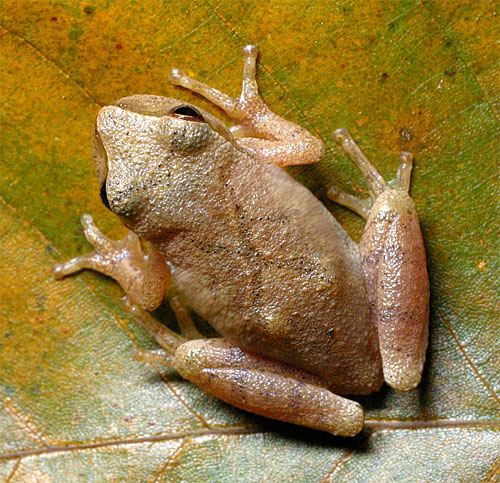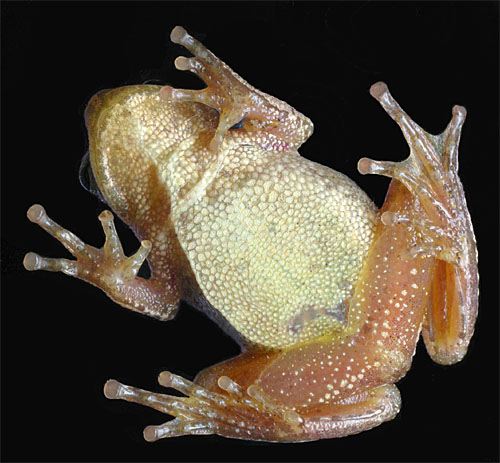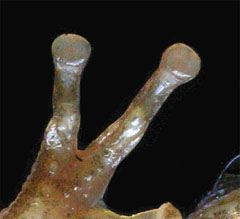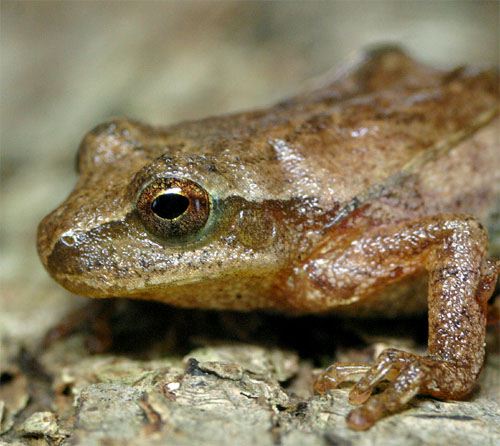SPRING PEEPERS PEEPING?
IT'S NOVEMBER ALREADY!
The fall season is well underway at Hilton Pond Center, with overnight temperatures continuing to creep downward as November unfolds. It's an interesting time of the year: Crystal-clear blue skies are now undiminished by summer haze and brown leaves continue to fall from deciduous trees; warm-weather butterflies have disappeared and Eastern Chipmunks are filling their larders in anticipation of truly cold weather to come; and Spring Peepers are sounding their mating calls in the crisp Autumn air. "Spring Peepers" . . . "mating calls" . . . "Autumn air" . . . well, if the juxtaposition of those phrases doesn't sound like an oxymoron, nothing does.

All text & photos © Hilton Pond Center
Indeed, we were walking the trails one coolish afternoon this week--marveling at how much the green vegetation of summer had changed in the past month or so--when we stooped to move a fallen branch along the path. The limb came down during recent wind and rain and was almost hidden by a blanket of dead leaves stuck together by moisture. As we lifted the stick, the leaves dropped away to the left but we thought we saw something small move away to the right. Ever on the lookout for living things in the leaf litter, we dropped to one knee and watched the spot where we saw movement. After staring for almost a minute, we finally perceived the shape of a tiny creature camouflaged perfectly against the leaves. It was a fully grown Northern Spring Peeper, which--with a snout-to-rump length of only an inch--is one of our smallest Piedmont frogs.
The trail where we found the peeper was at least 50 feet from Hilton Pond and certainly wasn't aquatic habitat. Nonetheless, the site was moist enough to keep the little amphibian's skin from desiccating, and we suspect the frog was almost ready to hunker down in a protected spot to spend the winter. It obviously had been active quite recently; when we grabbed it and cupped it in our hands, the peeper rewarded us with several dark droppings--indigestible remains of insects it had consumed in the past day or two.
The Northern Spring Peeper (top photo) is easily identified by a more or less distinct X-shaped mark on its back that gives rise to part of its scientific name, Pseudacris c. crucifer (crucifer meaning "cross"). Formerly called Hyla crucifer, the species is now classified as Pseudacris to show it is more closely related to Chorus Frogs than to other tree frogs. (Pseudacris, by the way, comes from Greek pseudes for "false" and akris for "locust," referring to the insect-like call of most Chorus Frogs.) If your field guide includes different scientific names for peepers and their relatives, it probably was published before recent laboratory analyses showed how taxonomy based on external morphological characteristics is often less accurate than taxonomy based on a frog's DNA.

Peepers do share one prominent, visible tree frog characteristic: The toe pad (above and below right), a round enlargement at the end of each digit that allows tree frogs to climb on virtually any vertical surface. Further facilitating the tree frog's arboreal gymnastics is an additional length of cartilage in each toe. This "intercalary" cartilage provides an extra flexible joint and allows each toe to swivel for exact placement, thus optimizing the toe pad's gripping surface.
 Northern Spring Peepers vary greatly in color. They are never green, but always some shade of dull gray, tan, yellow, or pink; we've even seen individuals that were bright brick red--about the same hue as our famous Piedmont red clay. The peeper's belly is pale and unmarked (see photo above)--except in the ventrally-spotted P. c. bartramiana, a southern subspecies with limited distribution in Georgia and perhaps the Savannah River basin. Northern Spring Peepers vary greatly in color. They are never green, but always some shade of dull gray, tan, yellow, or pink; we've even seen individuals that were bright brick red--about the same hue as our famous Piedmont red clay. The peeper's belly is pale and unmarked (see photo above)--except in the ventrally-spotted P. c. bartramiana, a southern subspecies with limited distribution in Georgia and perhaps the Savannah River basin.
In northern states, peepers hibernate under logs and bark but can breed October to March throughout most of the Carolinas (February to May in the higher elevations). Each mature female--one that's about three years old--can lay a thousand or more tiny jelly-covered eggs that she attaches one at a time to submerged rocks or vegetation. That's not bad production for a frog with a body only an inch long! Depending on ambient temperatures, eggs may take as few as four or as many as 14 days to hatch; tadpoles complete their metamorphosis in 2-3 months and emerge as fully formed half-inch juveniles. Like adults, the froglets dine primarily on small invertebrates--ticks and mites, caterpillars and other insects, spiders, and pill bugs.
Northern Spring Peepers range from southern Canada and New England south to central Georgia and west to eastern Texas. They occur primarily in forests old and new--in fact, their former generic epithet Hyla is Greek for "belonging to the woods." They usually frequent sites with a water source--most often a permanent pond, swamp, marsh, or slow-moving stream--but sometimes peepers are found deep into what appears to be a dry hardwood stand. This is a sure sign those woods were dotted by ephemeral, vernal pools that formed from winter precipitation and disappeared with summer's heat. As long as an adult creeper can keep its skin moist with dew and rain, its only real need for standing water comes during the breeding season.

The bottom line on all this is that just because it's late Autumn in the Carolinas doesn't mean that Northern Spring Peepers have gone into hibernation. They're just as likely to be active on a balmy day in January as during warm spring months. Unlike some amphibians that do hibernate when fall days get shorter, peepers are opportunistic and ready to take full advantage of occasional mid-winter warmth. Then they crawl out from under leaves or bark and make a bee-line for standing water, where hundreds of individuals may gather. Each male establishes a small territory and extends his spherical vocal sac, uttering a shrill "peep . . peep . . .peep." The louder and faster he peeps, the better his chances of attracting a receptive female.
Males usually compete in trios, and the male with the lowest-pitched call usually starts the vocal competition. All that repetitive peeping is a sound folks normally associate with spring breeding season, but it's exactly what we heard this week at Hilton Pond: Spring Peepers peeping--even though it's already November.
All text & photos © Hilton Pond Center
POSTSCRIPT: We don't usually publish poetry on the Center's Web site, but we couldn't resist including the following peeper-related verse we wrote on a warm winter day many moons ago whilst home from Newberry College on Christmas break.

ON THE FIRST DAY OF WINTER, 1967
Today’s the twelfth-month’s twenty-first,
According to Gregorian,
But Winter is one thing it isn’t.
Peepers chirp in the backpond while
Terminal buds scratch their metaphoric metamorphic heads
And wonder if they’ve mistallied sunrises.
Between them, though,
These harbingers of Spring had
Better give some second thoughts as to When.
All text, verse & photos © Hilton Pond Center
Comments or questions about this week's installment?
Please send an E-mail message to INFO.
NOTE: Be sure to scroll down for an account of all birds banded or recaptured during the week, as well as some other interesting nature notes.
"This Week at Hilton Pond" is written & photographed
by Bill Hilton Jr., executive director of
Hilton Pond Center for Piedmont Natural History.
You may wish to consult our Index of all nature topics covered since February 2000. You can also use the on-line Search Engine at the bottom of this page.
For a free, non-fattening, on-line subscription to "This Week at Hilton Pond," just send us an E-mail with SUBSCRIBE in the Subject line. Please be sure to configure your spam filter to accept E-mails from hiltonpond.org.

Catch the video version of "This Week" each Friday during the
6 p.m. newscast on CN2 cable news network in Rock Hill SC. (Repeated every half hour through the night.)
|



 Northern Spring Peepers vary greatly in color. They are never green, but always some shade of dull gray, tan, yellow, or pink; we've even seen individuals that were bright brick red--about the same hue as our famous Piedmont red clay. The peeper's belly is pale and unmarked (see photo above)--except in the ventrally-spotted P. c. bartramiana, a southern subspecies with limited distribution in Georgia and perhaps the Savannah River basin.
Northern Spring Peepers vary greatly in color. They are never green, but always some shade of dull gray, tan, yellow, or pink; we've even seen individuals that were bright brick red--about the same hue as our famous Piedmont red clay. The peeper's belly is pale and unmarked (see photo above)--except in the ventrally-spotted P. c. bartramiana, a southern subspecies with limited distribution in Georgia and perhaps the Savannah River basin.




 Oct 15 to Mar 15
Oct 15 to Mar 15 You can also
You can also